Commercial lighting design plays an important role in modern urban construction and architectural design. Commercial lighting design can not only improve the aesthetics and penetrating power of the space, but also add a unique atmosphere to the place and better display products and services. However, a good commercial lighting design must follow some basic principles and specifications to achieve good visual effects and user satisfaction. This article will introduce the basic principles and norms of commercial lighting design.
一. Basic principles of commercial lighting design
1. Suitability principle: The primary goal of commercial lighting design is to provide users and places with appropriate lighting levels and a comfortable light environment to meet the needs of different people. Based on this principle, commercial lighting design must ensure that users can feel appropriate brightness and color temperature at different positions and angles.
2. Principles of energy efficiency: Commercial lighting design should use resources reasonably to achieve the purpose of energy saving and emission reduction. Use high-efficiency lighting equipment, and adopt the appropriate number of lamps and lighting settings to achieve the purpose of optimizing lighting effects and reducing energy consumption.
3. Safety principles: Commercial lighting design must comply with international and domestic standards, follow life safety and fire safety requirements, and ensure that the design scheme has sufficient safety guarantees in both normal and emergency situations.
4. Convenience principle: Commercial lighting design must be convenient and easy to use, ensuring to provide users with a more comfortable, beautiful and practical lighting environment, while supporting people's various needs and activities such as study, work and leisure.
二. The specification of commercial lighting design
1. Specification of building functional requirements: Commercial lighting design should fully consider the actual needs of the site, and determine the appropriate lighting scheme and lighting settings according to the functions and characteristics of the site.
2. Energy-saving norms: Commercial lighting design must fully comply with national building energy-saving norms and standards to achieve the best energy-saving goals.
3. Requirements for lamps and lanterns: Commercial lighting design must select lamps and lanterns that comply with safety regulations and industry standards to ensure that there will be no negative effects such as heat and radiation.
4. Specifications for distribution of light and shade: Commercial lighting design needs to reasonably determine the light and shade, color temperature and direction of light according to the functions of the place and the needs of different users, so as to achieve the best visual effect and visual comfort.
5. Environmentally friendly and sustainable norms: Commercial lighting design needs to consider the principles of environmental protection and sustainable development, choose lamps and light sources that meet environmental standards, and reduce the impact on the natural environment.
In general, a commercial lighting design must follow the basic principles and specifications in order to achieve good visual effects and user satisfaction. Commercial lighting designers must have solid theoretical and practical abilities, and comprehensively consider communication, culture, process, environmental protection and other factors in order to provide customers with excellent commercial lighting design services.

 HK international lighting fair(Autumn Ed
HK international lighting fair(Autumn Ed
 What Type of Downlight Is Suitable for H
What Type of Downlight Is Suitable for H
 What Makes Recessed Down Lights Ideal fo
What Makes Recessed Down Lights Ideal fo
 Enhancing Outdoor Lighting with IP65 Rec
Enhancing Outdoor Lighting with IP65 Rec